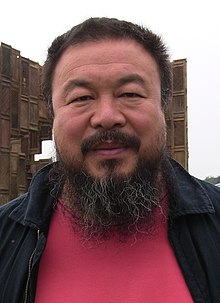Ai Weiwei
From Wikipedia, the free encyclopedia
- This is a Chinese name; the family name is Ai.
| Ai Weiwei | |
 Ai Weiwei |
|
| Born | 1957 |
| Nationality | Chinese |
Ai Weiwei (Chinese: 艾未未), born in 1957 in Beijing, is a leading Chinese artist, curator, architectural designer, cultural and social commentator.[1][2]
Contents |
[edit] Life and work
Born in Beijing, his father was Chinese poet Ai Qing, who was denounced during the Cultural Revolution and sent off to a labor camp in Xinjiang with his wife, Gao Ying.[3] Ai Weiwei also spent five years there.[2] Ai Weiwei is married to artist Lu Qing.[3]
In 1978, Ai enrolled in the Beijing Film Academy and attended school with Chinese directors Chen Kaige and Zhang Yimou.[4] In 1978, he was one of the founders of the early avant garde art group the "Stars". The group subsequently disbanded in 1983.[5]
From 1981 to 1993, he lived in the United States, mostly in New York, doing performance art and creating conceptual art by altering readymade objects.[5] While in New York, he studied at Parsons School of Design.[6]
In 1993, Ai returned to China because his father took ill.[7] Back in Beijing, he helped establish the experimental artists' East Village and published a series of three books about this new generation of artists: Black Cover Book (1994), White Cover Book (1995), and Gray Cover Book (1997).[8]

In 2000, he co-curated the exhibition "Fuck Off" with curator Feng Boyi in Shanghai, China.[9]
In 2006, Ai Weiwei and HHF Architects designed a private residence in Columbia County, New York for collectors Christopher Tsai and André Stockamp; according to the New York Times, the house, which was completed in 2008, is "extraodinarily refined" and is designed to incorporate a large contemporary Chinese art collection.[10][11]
Ai was the artistic consultant for design, collaborating with the Swiss firm Herzog & de Meuron, for the Beijing National Stadium for the 2008 Summer Olympics, also known as the "Bird's Nest."[12] Although ignored by the Chinese media, he has voiced his anti-Olympics views.[2] He later distanced himself from the project, saying, "I've already forgotten about it. I turn down all the demands to have photographs with it," saying it is part of a "pretend smile" of bad taste.[13][14] In August 2007 he also accused those choreographing the Olympic opening ceremony, including Steven Spielberg and Zhang Yimou, of failing to live up to their responsibility as artists. Ai said "It's disgusting. I don't like anyone who shamelessly abuses their profession, who makes no moral judgment."[15] While being asked why he participated in the designing of the Bird's nest, Ai replied "I did it because I love design."
[edit] Exhibitions
His artwork has been exhibited extensively in Australia, Belgium, China, France, Germany, Italy, Japan, Korea and the United States. His work was included in the 48th Venice Biennale 1999, Italy; the First Guangzhou Triennial 2002, China; "Zones of Contact: 2006 Biennale of Sydney"; and Documenta 12, where his monumental outdoor sculpture titled "Template" collapsed after a storm.[16]
[edit] References
- ^ "Ai Weiwei". Wolseley Media. 2008. http://www.wolseleymedia.com.au/AP-Ai-Weiwei.html. Retrieved on 2008-07-06.
- ^ a b c Cooper, Rafi (2008-07-06). "Cultural revolutionary". The Observer. http://arts.guardian.co.uk/art/visualart/story/0,,2289411,00.html. Retrieved on 2008-07-06.
- ^ a b Meacham, Steve (2008-04-24). "Child of the revolution in revolt". Sydney Morning Herald. http://www.smh.com.au/news/arts/child-of-the-revolution-in-revolt/2008/04/23/1208743040711.html. Retrieved on 2008-07-06.
- ^ Blackwell, Adrian (2006-12-05). "Ai Weiwei: Fragments, Voids, Sections and Rings". Archinect. http://archinect.com/features/article.php?id=47035_0_23_0_C. Retrieved on 2008-07-06.
- ^ a b "Ai Weiwei". Groninger Museum. 2008-02-28. http://www.groningermuseum.nl/index.php?id=3963. Retrieved on 2008-07-06.
- ^ Aloi, Daniel (2006-11-15). "Ai Weiwei literally smashes China's traditions in art and architecture". Cornell University. http://www.news.cornell.edu/stories/Nov06/Chinese.artist.dea.html. Retrieved on 2008-07-06.
- ^ Toy, Mary-Anne (2008-01-19). "The artist as an angry man". The Age. http://www.theage.com.au/news/in-depth/the-artist-as-an-angry-man/2008/01/18/1200620207518.html?page=fullpage. Retrieved on 2008-07-06.
- ^ Napack, Jonathan (2004-08-02). Ai Weiwei: Works Beijing 1993-2003. Timezone 8. p. 148. ISBN 9889726289.
- ^ Vulliamy, Ed (2008-06-29). "The nest generation". The Observer. http://www.guardian.co.uk/sport/2008/jun/29/olympicgames2008.china. Retrieved on 2008-07-06.
- ^ Nicholson, Louise (2006-11-01). "Art to live with". Apollo. http://findarticles.com/p/articles/mi_m0PAL/is_537_164/ai_n16865261. Retrieved on 2008-07-06.
- ^ The New York Times: “Global Summit”
- ^ "Artist behind Beijing's 'bird's nest' stadium boycotts Olympics". CBC News. 2007-08-11. http://www.cbc.ca/arts/artdesign/story/2007/08/11/beijing-artist-stadium.html. Retrieved on 2008-07-06.
- ^ "Stadium designer blasts China Olympics". Al Jazeera. 2007-08-12. http://www.youtube.com/watch?v=R-CdWcszb_8. Retrieved on 2008-07-06.
- ^ "Chinese architect slams Olympic 'pretend smile'". CNN. 2007-08-13. http://edition.cnn.com/2007/WORLD/asiapcf/08/13/china.olympics.reut/?iref=mpstoryview. Retrieved on 2008-07-06.
- ^ Watts, Jonathan (2007-08-11). "Olympic artist lashes out over PRC propaganda". Taipei Times. http://www.taipeitimes.com/News/editorials/archives/2007/08/11/2003373696. Retrieved on 2008-07-06.
- ^ Art Forum
[edit] External links
- Ai Weiwei's official site
- Ai Weiwei's blog
- Ai Weiwei interview from The New York Times, August 4, 2008
- Ai Weiwei's news in English, from China Digital Times.
- Ai Weiwei at Louis Lannoo Gallery

